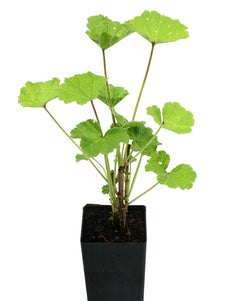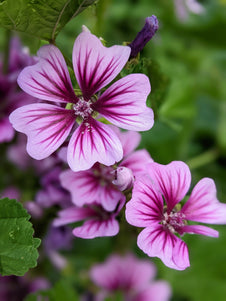







Common Mallow
Common Mallow

- Low stock - 7 items left
- Inventory on the way

Usually available: All year
Life cycle: Annual
Height: 60cm - 1.2m
Position: Sun / part shade
Soil preference: Well drained
This is how we pack and send your Herb Plants to all states except TAS & WA
You will receive
- 1 Common Mallow Herb Plant in a 50 X 75mm tube - General growing instructions
All of our Herb Plants are grown organically with certified organic potting mixes and fertilizers
Botanical Name: Malva sylvestris
Malva sylvestris is a spreading and clumping perennial known for its prolific and long flowering period. It grows from 60-120cm, depending on conditions and spreads from 45-60cm. Plants up to 3 meters have been seen in the natural environment. Also known as Common Mallow, this plant has leaves of deep green which are round with 3, 5, 7 or 9 lobes. Each leaf is 2-4cm long by 2-5 cm wide, with prominent veins and it may also be downy on the underside. As summer progresses the leaves and stems may become a little ragged looking.
The flowers are held in axillary clusters of 2-4 and appear at irregular intervals around the strong, round stem. The deep purple petals are up to 2.5 cm each with flower size up to 5cm. There are 5 petals on each flower, fanning out delicately from the richly coloured centre. The lobed petals generally have deep veins, which carry the bold and deepening colour out from the centre to the edges. It blooms from summer to autumn, with the flowers closer to the base of the plant opening first. This plant is self-fertile and performs well as a bee and butterfly attractant. The fruit or nutlets that hold the brown seeds are called mericarps and resemble cheese wheels.
The Malvaceae or mallow family of plants is large, having over 1000 species, with most found in tropical regions of the world. Malva sylvestris is native to North Africa, Asia and across Europe and into Great Britain, where it grows naturally in moist ground. It has also become naturalised in Eastern Australia and parts of the United States and Canada due to garden escapees. The name is said to be from the Greek ‘malate’ meaning soft and was given due to the softening and healing qualities of the plants. It may also be derived from the Greek word ‘malaxos’ which means slimy. Many are common garden plants, including its famous cousin, the hollyhock and the hibiscus.
There can be confusion with the common names, since Malva sylvestris is called Common Mallow and Marsh Mallow across Europe. However, the true Marsh Mallow (Althea officinalis) has more mucilage and may be distinguished by the many divisions in the outer calyx, a feature not present in Malva sylvestris. Other common synonyms are Blue Mallow, because the purple flowers turn blue upon aging or Country Mallow as used by Germans. Other common names include Cheeses, French Hollyhock, Striped Mallow, Garden Mallow, High Mallow, Tall Mallow and Round Leaf Mallow. Scientific synonyms include Althea godronii, A. mauritiana, Malva ambigua. M. erecta and M.mauritiana. However, some of these names apply to sub species.
Traditional use included using the flowers to be woven into garlands on May Day. Each satin sheened flower petal is reminiscent of a glamorous mauve ball gown, cinched in at the waist, where it meets the other four petals. Today, this plant’s stunning floral display is valued in cottage gardens and in the garden backdrop. However, the Common Mallow also has a history of medicinal use, along with the Marshmallow plant which is also in our catalogue.
Growing Conditions
Common Mallow is hardy, a vigorous grower and does not require much care for the average gardener. It prefers full sun, but will take dappled shade quite well and still flower profusely. This plant will grow happily in all soil types, as long as the ground is well drained. This plant will grow well in poor soil, but fertile soil will help to provide a sweeter taste to the young salad leaves. Water requirements are average, but a regular supply is required so the soil stays moist.
Propagation is via seed, which will self-sow if given the chance. Pollination is via bees, but the plant is self-fertile. Often the first year the plant may flower so profusely that it literally dies of ‘exhaustion’, but usually it remains a short lived perennial or biennial in most areas. It should return after dying down in winter in cold areas. However, if it is too cold then it is worth replanting seeds annually due to the long flowering period. Staking may be necessary if the plants grow too tall to support the many flowers. If planted in a very damp area the plant may be subject to fungal infection.
Medicinal Uses
Malva sylvestris has a strong history of medicinal use by herbalists, due to the presence of mucilage, which is valued for the moistening and soothing effects. The medicinal value and mucilage content is less than that found Althea officinalis, the Marsh Mallow plant. However, the Common Mallow was traditionally used in areas where other mallows did not grow naturally. The fruit and seeds have the highest mucilage content and are often used to prepare a decoction or herbal tea for internal use. The leaves are used to make poultices used to heal wounds, rashes, insect bites and other skin problems. It may be used to make an external emollient. The volatile oil made from the roots, leaves and seeds, is valued for astringent, anti-bacterial and anti-fungal properties. Other uses include treatment for toothache and insomnia.
In Germany, the Common Mallow is recommended for soothing throat mucosa and persistent dry cough. It is also believed to be anti- asthmatic and to help in relieving bronchial and respiratory disorders. When taken internally, the active components act as a demulcent and help to sooth irritated mucous membranes. It is particularly useful as a diuretic and laxative, and for digestive and urinary tract complaints. The effects of this plant are also active on the Central Nervous System (CNS) and act as a CNS depressant, relieve anxiety and nervousness. Due to this action, the Common Mallow has the potential to interact with some medications.
There are many mallow species and sub species, with the result that the name ‘common mallow’ may apply to different plants (and species) depending upon where in the world it is found in abundance. Check the plant for identifying features and confirm the species before using the plant for health treatments, as some plants may have side effects.
Culinary Uses
The mallow family have been used as a vegetable food source for centuries particularly in 19th century Europe. The leaves may be boiled, fried or eaten raw when young in salads. They are particularly pleasant when used in soups, having a mild but pleasant flavour. The leaves will also make a tea substitute and the seeds are said to have a nutty taste.
Other Uses
The plant can be used to obtain a cream, yellow or green dye. The stem may also be used for textiles, paper making and cordage.
All information provided on this website is for informational purposes only. Please seek professional advice before commencing any treatment.





